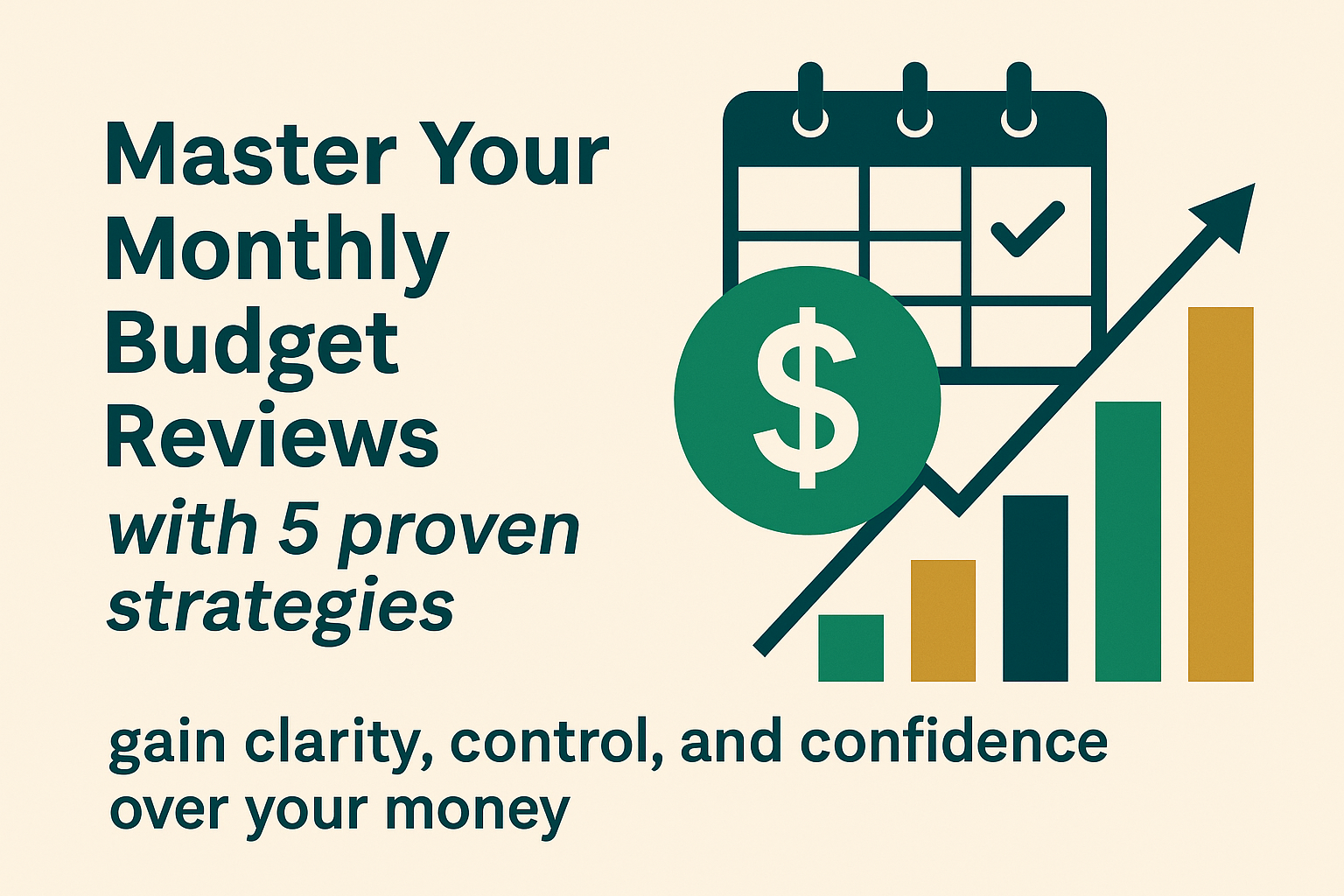I. Introduction: Turning Budget Review from a Task into an Opportunity
Do you get scared when you hear the words “monthly budget review”? Do you put off this important financial check-up until the last minute or skip it altogether? You’re not the only one. Many people find budget reviews to be boring tasks full of reconciling transactions and self-criticism: “Why did I spend so much on takeout? I’m never going to reach my savings goals.” These feelings of being overwhelmed and guilty often lead to inconsistency, missed chances to grow your money, and, in the end, no progress in your personal finances.
But what if we told you that the monthly budget review doesn’t have to be a scary job? What if you could make it a routine that gives you power, makes you think, and even makes you happy with the right strategies? If you think of this process as a dynamic tool for clarity and control instead of a judgmental audit, you can turn your financial data into useful information that helps you reach your goals.
The point of this article is clear: to reveal and go into great detail about the Top 5 Proven Strategies for doing a monthly budget review that really works. We want to give you the knowledge, skills, and tools you need to feel more in control of your money based on years of financial coaching and data-driven insights. By strictly following the EEAT guidelines, which stand for Experience, Expertise, Authoritativeness, and Trustworthiness, this guide will become your go-to source for successful budget reviews, useful budgeting tips, and strategies for monthly financial reviews.
II. Understanding the Main Purpose of Reviewing Your Monthly Budget
The Analytical Edge: More Than Just Tracking
Tracking your spending is just the first step; it’s about gathering data. That raw data turns into useful information at the monthly budget review. It’s your chance to take a step back, look at trends, and make changes on purpose—turning numbers into a guide to financial success.
The Most Important Benefits of a Monthly Review That Works
- Finds leaks and patterns in spending Find out exactly where your money goes, including unnecessary purchases and small, regular “drip” expenses that slowly eat away at your budget.
- Helps you reach your goals Check your progress toward your savings, debt repayment, or investment goals to make sure you stay on track.
- Allows for quick changes Life happens: you might have to pay for car repairs, medical bills, or changes in your income. A review lets you change course before small problems turn into big ones.
- Lessens Stress About Money A clear plan instead of uncertainty helps you feel better, lowers your anxiety, and lessens your worries about money in the future.
- Increases Knowledge About Money Regularly dealing with your money helps you learn more about the rules of personal finance and the economy as a whole.
- Encourages Responsibility Seeing your numbers gives you power; a review makes you responsible for how you spend your money and helps you make smart choices.
- Finds ways to save and grow Find ways to cut costs, move money to investments that pay more, or get better service rates.
The Bad Things About Ignoring Reviews
If you skip or do a bad job on budget reviews, you could end up with financial drift, which is when your spending habits slowly eat away at your savings goals without you even noticing. Not paying off debts on time, subscriptions that go unchecked and drain your account, or too much discretionary spending can all lead to more stress and less money.
III. Getting Ready for the Review: Setting the Stage for Success
1. Pick the Right Tools
- Budgeting apps: use automation, categorization, and strong reporting. Mint, YNAB, Personal Capital, and Simplifi are all popular options. Look for things like dashboards that let you track your goals, customizable categories, and notifications in real time.
- If you want more control and flexibility, make digital worksheets in Excel or Google Sheets. You can use built-in formulas, pivot tables, and charts to see how much you spend.
- If you like to touch things, paper ledgers or bullet journals are good ways to keep track of things.
2. Give Space and Time
Set aside time for an appointment with yourself when you won’t be distracted. You should treat it as non-negotiable, whether it’s an hour on the first Saturday morning or a weekday evening. To make reviews a habit, you need to be consistent.
3. Put all of your financial information in one place.
Make sure that all of your accounts, including checking, savings, credit cards, investments, and loans, are linked or that you have downloaded their statements. Having one place to import transactions makes it easier to keep track of your money and reconcile your accounts.
4. Do as much as you can automatically
Set up automatic imports of transactions, payments of bills that happen on a regular basis, and transfers of savings. Automation cuts down on manual work, so you can spend more time on insights instead of data entry.
5. Think “Curiosity, Not Judgment”
When you look at your numbers, think like a detective and try to figure them out instead of criticizing yourself. This way of thinking helps you learn because it lets you ask useful questions like, “Why did this category go up?” instead of “Why am I so bad with money?”
6. Get the papers you need
Collect:
- Statements from the bank
- Statements for credit cards
- Pay stubs
- Receipts for big cash purchases or transactions that don’t happen often
IV. The Five Best Ways to Review Your Monthly Budget Successfully
Strategy 1: Use the “Micro-Review” all month long (the proactive approach)
Idea
Instead of one big, stressful end-of-month marathon, break your review into smaller, more frequent check-ins.
Why It Works
- Prevents Data Overload: Handle only a few transactions at a time.
- Real-Time Adjustments: Find out about budget problems right away instead of weeks later.
- Less Anxiety: Smaller sessions seem less scary.
How to Put into Action
- Quick Look Every Day (5 Minutes) Check balances, sort new transactions into categories, and flag any problems.
- Check-In Once a Week (15–20 Minutes) Look over your spending in the most important areas, compare your budget to what you actually spent, and change your upcoming discretionary spending.
- Mid-Month Pulse Check (30 minutes) Go deeper: look at the big picture, any unexpected costs, and make plans for the second half of the month.
Advice and Tools
- Allow push notifications for big purchases.
- Make a habit of reading your review (like drinking coffee on Monday mornings).
Strategy 2: Start with “Big Wins” and then narrow your focus (the Pareto Principle of Budgeting)
Idea
Use the 80/20 rule: 20% of categories are responsible for 80% of overspending. Before you worry about the little things, take care of the big things first.
Why It Works
- Maximize Impact: Give the most important changes that save the most money top priority.
- Avoids Detail Fatigue: Don’t worry about small drips until the big leaks are fixed.
How to Put into Action
- Find the top three to five categories of spending Housing, food, transportation, debt payments, and entertainment are all common problems.
- Take a Close Look at These Look at the difference between the actual and the budget. Find out what keeps going wrong.
- Analyze Recurring Discrepancies Which category always goes over budget by the most?
- Wide Sweep for Little Leaks Look for expenses that you don’t notice very often, like unused subscriptions, several small coffee runs, or bank fees that are rounded up.
Tools and Advice
- Use the “category breakdown” charts in your app.
- Sort transactions by amount to show the biggest outflows.
Strategy 3: The “Future-Forward” Review: Plan, Change, and Look Ahead (The Proactive Planner)
Idea
A budget review isn’t just looking back; it’s also about planning ahead to make sure your next cycle is well-informed and well-planned.
Why It Works
- Avoiding Budget Busts: Plan for big costs before they happen.
- Keeps things relevant: Change your budget when your life changes, like when you get a new job, move, or change your priorities.
How to Put It Into Action
- Change the budget for next month If you always spend too much on “dining out,” raise that category and lower another one. If you always spend too little on “groceries,” move money around.
- Plan for Unexpected Costs Check the calendar for upcoming birthdays, vacations, insurance payments, or vehicle registrations. Make specific categories or sinking funds.
- Set goals that you can reach “Add $100 to your emergency fund,” “Reduce impulse buys by 20%,” or “No-spend week” are some examples.
- Check out automated payments and subscriptions Cancel services you don’t use, make sure you know about any rate changes, and make sure you are responsible for future bills.
Advice and Tools
- Use the “future budget” or “recurring transactions” features in your app.
- Keep a list of your yearly and quarterly costs.
Strategy 4: Link Spending to Your Values and Goals (The Motivational Driver)
Idea
To make your review more meaningful and motivating, link your spending habits to deeper financial values and long-term goals.
How It Works
- Empowerment: You can use budgeting to help you build the life you want.
- Intrinsic Motivation: Making cuts that hurt your wallet but help your dreams come true makes them feel less like punishment.
How to Put into Action
- Think about your “Why” again Keep your big goals in mind, like buying a house, getting out of debt, retiring early, or saving money for travel.
- Check to see if your spending is in line with your goals. “Does this move me closer to my goals or further away?” for big overspends.”
- Find Spending That Matches Your Values Celebrate the things you buy that help you reach your goals, like online courses, gym memberships, or smart investments.
- Find spending that doesn’t match up with value If a purchase doesn’t make you happy or help you reach your goals, it’s a good candidate for cutting back.
- Use pictures A lot of apps let you tag your spending by goal, showing progress bars or categories for each goal.
Tools and Advice
- Make a vision board for your financial goals, either online or on paper.
- Add context to your transaction notes by saying things like, “Bought travel guide—progress toward trip.”
Strategy 5: The “Accountability and Celebration” Loop (The Way to Make Things Happen)
Idea
The only thing that makes a review process good is how long it lasts. Add ways for people to be held accountable and rewarded for good behavior.
Why It Works
- Keeps You from Getting Burned Out: Celebrating regularly makes the boring work of number-crunching more bearable.
- Encourages Good Behavior: Recognizing wins, no matter how small, makes people want to do better.
- Encourages Continuous Improvement: What you learn from mistakes helps you do better reviews in the future.
How to Put into Action
- Recognize the Work Just finishing a review is a win!
- Celebrate Your Wins Under-budget categories, savings goals, or extra payments on debts. Give yourself a reasonable reward, like a small treat, time with loved ones, or a fun activity that doesn’t make you feel bad. 🎉
- Learn from your mistakes without feeling bad If you spent too much money, think about why—stress shopping, subscriptions you forgot about, or events that came up out of the blue—and write down what you need to do to fix the situation.
- Write down important insights Write down the most important things you learned in a simple journal or app note. For example, “Plan meals to cut down on eating out” or “Set up auto-savings for bills that come up unexpectedly.”
- Think about getting an accountability partner. Get a different point of view and some support by sharing your monthly review with a trusted friend, partner, or financial coach.
Advice and Tools
- Use built-in progress dashboards to help you remember.
- Keep a short budget journal to help you think about things and keep track of your insights.
V. Picking and Improving Your Budget Review Tools
A summary of the different types of tools
- Apps for budgeting are best for automating tasks, sending real-time notifications, and keeping track of goals in one place.
- Spreadsheets are great for people who want to customize things, do advanced analysis, or prefer to do things by hand.
- If you like to touch things, paper ledgers or bullet journals are good ways to keep track of things.
What to Look for in a Review Tool
- Strong reporting: trends, category breakdowns, and timeframes that you can change.
- Customizable Categories and Tags: Make your spending fit your unique lifestyle and goals.
- Integration for tracking goals: progress bars, achievements, and alerts.
- Easy to reconcile transactions: Bank-level imports, automatic categorization, and support for split transactions.
- Security and Privacy: Bank-level encryption, multi-factor authentication, and clear privacy policies.
Making Your Tool Unique
- Custom Tags: Tag transactions by person, event, or reason.
- Saved Reports: Make a template for a “Monthly Review” report that you can use over and over again.
- Recurring Transaction Templates: Set up known bills ahead of time so you don’t have to do it by hand.
- Alerts and notifications: warnings about low balances, reminders about upcoming bills, or alerts about going over budget in a certain category.
VI. Getting past common problems with budget reviews
| Problem | Solution |
| “I don’t have time!” | To make reviews a part of your daily life, use the Micro-Review strategy: look at them for five minutes every day and check them for fifteen minutes every week. Automation cuts down on a lot of manual work. |
| “It’s Too Hard!” | First, think about the big wins. First, fix the biggest leaks in your budget, and then move on to the smaller ones. |
| “I Get Discouraged When I Spend Too Much!” | Instead of judging, be curious and use the Accountability & Celebration loop to help you learn from your mistakes and keep making progress. |
| “My income and expenses aren’t steady!” | Use zero-based budgeting for income that changes and make buffer categories, like a “flex fund” for costs that come up unexpectedly. |
| “I Forget to Do It!” | Make an appointment on your calendar for your review and set reminders. Think of it as a meeting that can’t be changed. |
| “Concerns about security” | Use only trusted tools like Mint, YNAB, or Personal Capital, and make sure they have SSL encryption, SOC-2 compliance, and clear privacy policies. |
VII. The Future of Budget Review: What to Look Out For
- Insights from AI Expect apps to have more predictive analytics, personalized spending forecasts, and AI-driven financial coaching built right in. 😎
- Gameification Reviews will be more fun with progress badges, challenges, and a social leaderboard.
- Financial ecosystems that work together A complete view by making it easy for budgeting tools, investment platforms, tax software, and insurance companies to work together.
- Integrating Behavioral Economics Apps use psychological tricks like nudges, default options, and loss aversion to help people make better money decisions.
- Hyper-Personalization Reviews that are tailored to your life stage, income level, and personal goals for maximum usefulness and relevance.
VIII. Questions that people often ask
How often should I go over my whole budget? A full review once a month, along with daily and weekly micro-reviews, makes sure that both depth and flexibility are present.
How long should a monthly budget review last? Try to get 45 to 60 minutes. Micro-reviews help share the work and keep the last session on track.
Can looking over my budget help me find financial fraud? Yes, for sure. Regular transaction reconciliation brings unauthorized charges to light early.
Should I look at my investments and debts when I review my monthly budget? Yes. As part of your overall financial picture, keep track of your investment contributions, portfolio performance, and debt repayment progress.
What if I don’t use an app to help me budget? Can these strategies still work? For sure. You can use the same ideas in spreadsheets or by hand, like categorizing, looking at trends, and planning for the future.
What should I do if I have to pay for something I didn’t expect during my review? Put them in a buffer or “unexpected” category, and then change next month’s budget or your annual sinking funds.
Can I change my budget in the middle of the month? Yes. Changes in life, like changes in income, events, or emergencies, mean you need to make mid-cycle adjustments to stay on track.
What is the difference between checking my budget and reconciling my transactions? Reconciling makes sure that everything is correct (every transaction is counted). Reviewing looks for patterns, sets goals, and helps make changes.
How can I get my partner to help me go over the budget? Set it up as a project that everyone is working on together. Use the Accountability & Celebration loop to build teamwork and celebrate wins as a group.
What numbers should I pay the most attention to during a review? The most important categories of spending, total discretionary vs. non-discretionary spending, savings rate, progress on paying off debt, and progress toward important financial goals.
IX. In conclusion, your way to financial freedom is through
A good monthly budget review isn’t about being perfect; it’s about putting in the same amount of work every month. You can turn your reviews from things you hate doing into powerful tools for getting clear about your finances, taking control of them, and growing them by using the Top 5 Strategies: Micro-Reviews, Big-Wins First, Future-Forward Planning, Values-Alignment, and Accountability & Celebration.
Summary of Benefits:
- More Clarity: You will know exactly where your money goes.
- More Control: Be ready for changes in life.
- Less Stress: Make a clear plan instead of being unsure.
- Faster Progress: Make clear progress toward your savings, debt repayment, and investment goals.
Call to Action:
Pick one or two strategies, like the Micro-Review routine or the Values-Alignment approach, and put them into action right away this month. Not being perfect, but being consistent is what will help you master your finances for good.
Final Empowering Thought: By using these strategies, you’re not just keeping track of your transactions; you’re also changing your financial future, one powerful monthly review at a time. Take charge, get clear, and make the life you want. 📈






